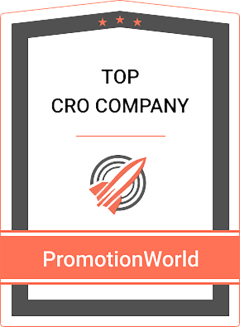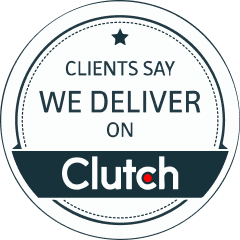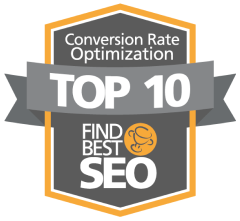Yosef Levenstein | Chief Marketing Officer | Golden Section
Join us as Yosef describes B2B marketing strategies from a venture capitalist’s perspective. Efficiency of capital is critical in startup and early growth stages, driving every decision. Yosef shares tidbits on achieving those efficiencies both in big-picture marketing strategies and tactical campaigns.
Transcript
[Laura] Welcome back. This is season two, episode one of The CMO’s Guide to Everything, and we are so happy to have with us today, Yosef Levenstein with Golden Section. Yosef has had over 10 years of experience in sales and marketing and has spent much of his career in financial technology across a spectrum of business roles. Before joining Golden Section, as it’s CMO, he was the head marketing at Iownit, a Houston based FinTech startup. At Golden Section, Yosef oversees marketing sales and client success. As CMO he focuses on making sure that all the parts are moving together efficiently and effectively. He graduated from Yeshiva University with a degree in economics in 2008, just in time for that big financial crisis. When he isn’t working, he loves to spend time with his family, hang out in the kitchen with his wife, or play basketball with friends.
Welcome, Yosef.
[Yosef]: Hello, thank you for having me, Laura.
[Laura]: Of course. Yes. So to start, can you tell us a little bit about Golden Section and what sets you apart from other VC firms?
[Yosef]: Sure, absolutely. So Golden Section is a venture capital fund, but within the firm, we also have a venture studio and a team dedicated to product development. And what we found is that by combining our expertise in building business to business SaaS companies, the products that guide those companies, and working closely with the founders to help them build their products, we’re able to find opportunities to invest in really strong founders and good companies and help them grow and achieve meaningful exits.
[Laura]: Okay. Great. So can you describe maybe a little bit of the origin story for Golden Section and what benefits you’ve seen from that partnership with your portfolio companies?
[Yosef]: Sure. So Golden Section has actually been around in some form since 2009. And in 2009, essentially our two principals at the firm had their own business-to-business software companies that they built up and brought towards meaningful exits. And then over time, they realized that the process of building out a platform that is geared towards business-to-business types of solutions had a certain structure that people were either missing or founders weren’t necessarily aware of. And that ended up leading to founders making mistakes that would lead to the company’s failure. And they thought, “Well, if we can bring out our experience and help them build the product and avoid those mistakes, then you would have more successful business-to-business platforms built out.” And then over time as they were helping these companies build their product and investing in different capacities they said, “Well, what if we also set up our own fund and started investing in these companies as well?”
And so in 2019, they launched Golden Section ventures. And from there… I joined just recently, but from there they started investing in business-to-business SaaS companies and growing out our portfolio, and growing out our product development team. And most recently starting a venture studio to help even earlier stage founders avoid those mistakes, figure out how those commonly made mistakes that business to business founders tend to make, and build out their platforms in a way that is both stable, scalable, and helps the founders build out revenue and really scale up their companies again, towards a meaningful exit for them. And as they become our portfolio companies for the fund as well.
[Laura]: That’s really interesting. And so, you have a built-in advisory board, as soon as you start working with someone, you know that experience can be really vital, especially on the front end of a startup like that.
[Yosef]: Absolutely. And with a venture studio, we partner our founders with a venture partner and they are there to provide knowledge, right? So we don’t look at it and say, “Here’s a prescription of how to build a platform.” But rather we provide a framework, a way to think about the different challenges that these founders are going to face and we provide the framework to say, “Well, let’s start thinking about this ahead of time so that when this challenge arises…” Because it will, you have a plan in place and most importantly you avoid the mistakes, and avoiding the mistakes, doesn’t guarantee success, but making those mistakes merely guarantees failure.
[Laura]: That’s true. Wow. And it’s a whole lot less expensive if you can avoid the mistakes. Some things are not life-threatening, they’re not critical, but they sure are expensive. So to be able to avoid that it has a lot of value.
[Yosef]: Yeah, absolutely. And to your question about the differentiating factor from the venture capital fund, one of the things that we focus on is capital efficiency. And so, to that extent, what that means is ensuring that the companies that we invest in are put in a position where they will not need to have multiple rounds of capital raising in order to succeed, in order to thrive. And by doing that, we ensure, or at least try to ensure that the founders maintain a significant percent of equity in their companies so that when they do achieve a meaningful exit, they have a bigger stake in the company that they grow and bring to that point.
[Laura]: Everybody wins, that’s a great approach. So I’m looking at your background, what do you think of your background has uniquely prepared you to be CMO?
[Yosef]: So I spent a lot of my career in business to business SaaS startups and in different capacities, seeing both the results of some of the mistakes and also what happens when you avoid the mistakes at these companies. And so, having that firsthand experience, being a part of startups that are trying to build these types of solutions whether it’s for small businesses or enterprise, or both. Having that experience, both from the sales marketing and client success perspective helps me understand a lot about the companies that we’re working with. And so, whether it’s defining the persona of a founder at a B2B SaaS company and figuring out how to target them, or simply having conversations with these firms that we’re working with to understand what it is that made us stand out to them, that they’ve chosen to work with us, but also communicating to them in a language that they understand is really helpful.
And so, having that firsthand experience with growing companies, building companies has positioned me where now I can say, not only that I can communicate to them, but put myself into people that we’re trying to engage with in their shoes. And in marketing, that’s a pretty big part of it. Being able to put yourself in the other person’s shoes and say, what is it that’s going to resonate with them? What’s the message? What’s the content? What’s the answer that they may be looking for? What’s pain that they’re having? And whether it’s in a blog post, social media post, or just on one on one communication representing the firm to founders or to investors, or to just the general ecosystem, being able to communicate that in a fairly clear way.
[Laura]: Definitely. And when it comes to B2B marketing, do you have any guiding philosophies that have served you well?
[Yosef]: So I’ve always found that the human element is really important and connecting with people. Right? A lot of the times, I think when people look at B2B marketing, they’re looking at it as an organization that you’re engaging with, but at the end of the day you’re engaging with people at that organization. And those people are engaging with you because they have some sort of challenge. So previously it was identifying asset managers at my other firms or identifying registered investment advisors and figuring out what their pain points were. And in this scenario at Golden Section it’s really about understanding the founders and where they’re coming from and addressing their questions or surfacing questions that they may be thinking of and may resonate with them and engaging with them as people.
And at the firm, we look at everyone that we engage with as a part of our community. And so, we want to make sure that we’re connecting with people also that are teachable and are honest and are kind and are aligned with our values. And so, in order to do that, you need to connect with them even though you’re connecting with another business, you’re connecting with the founders, the people that are driving that business.
[Laura]: I think that gets lost so often. And I’m so glad you brought that out that, yes, it’s business to business, yes, this is a corporate deal but at the end of the day, they’re still people, they still go home and put on their pants, one leg at a time, they still have the same habits, it’s a person and I really like that focus on the human element. So when you’re looking at social for 2022, you mentioned community, and I know social is perhaps not the only, but it is a big part of that. How do you see that perhaps playing out in 2022?
[Yosef]: So a key part of my strategy is building out the Golden Section brand and getting more people to know what we do and how amazing it is, what we’ve built here at the firm. So in order to do that, I’m looking at social networks as a key channel to engage with our target market. And a key part of my strategy is when I look and I say, “Well, we want to connect with people and we want them to know what it is that we’re doing and what it is that we can offer to them.” And so, putting a significant amount of resources and budget into Facebook, because that’s where people are. That’s where people are sort of spending their time as humans, less so with their business hat on and more in their personal life.
But that’s really more about creating that brand awareness and marketing to them. So they know what Golden Section is, but actually engaging with them directly on LinkedIn. And so, on LinkedIn spending less money, but being more personal and connecting with people on a more personal level there. And so tying those two networks together where they’re familiar with Golden Section from Facebook and from brand awareness campaigns there, but that we actually are engaging with and connecting with them on LinkedIn and the middle tied to that is driving them into a funnel of some sort through our CRM. And so, making sure that if they do engage with us through Facebook, that we know who they are and that we can then re-target them on LinkedIn. But the engagement on LinkedIn is really going to be more from a personal level. And then obviously there’ll be an element of our social presence as a firm sharing content there.
But again, on LinkedIn then the way I look at it and the strategy is that, when the firm shares content, I’m not depending on our employees to then go and share the post from our firm. I’m actually creating a post that each of them can share to their own networks. And then they’re creating their own original content that is based on the content that we’re creating to share with their networks. And so then you get this much broader reach and a more personal reach from our own stakeholders, our employees, who everyone here buys into the vision and feel strongly about it. And so, just giving them that ammunition that they need to go out and say, “Hey, here’s something that we’ve shared. And here’s how we’re thinking about it.” And giving it their own sort of personal voice as they share that. But with a foundational piece of guidance that we as the marketing team create for them to share.
[Laura]: Okay. So a little bit of a digging question, Facebook’s gone through some pretty big changes, they’ve rebranded to Meta now. Do you see that as a declining platform?
[Yosef]: If you look at just Facebook, maybe, but there’s still a lot of traffic and there’s a lot of targeting capabilities on there, especially when we’re looking at it from a geographic or business line perspective. But part of the reason why I like Facebook also is because when you run ads through Facebook, they’re not just appearing on Facebook. They’re going to go across their other platforms as well. And similar to Google, right? For me, Facebook and Google are the two most powerful marketing platforms from a business-to-business perspective, because what I know is that when I put and run a campaign through there, I can in one… Let’s call it a channel, but not exactly a channel, but through one platform, I can actually reach multiple platforms. So it’s a much more efficient way to have that broad reach versus just running something on Instagram or just running something on YouTube. I’d rather run across the platform, and let them do a lot of the optimization to make sure it’s reaching the right platform, the right audience.
So yes, Facebook maybe has gotten some bad press and there’s some jokes around their Meta rebrand, but there’s still getting a lot of traffic and it’s still where people are spending their days. I know I spend a good chunk of time on Facebook every single day for personal engagement and to see what’s going on with my friends and family around the world. And a lot of other people still do that.
[Laura]: Sure. Absolutely. Okay. So we can leave the diverse topic of Facebook. So if you were to speak to entrepreneurs, I’m sure you do all the time, and marketers at early growth phase companies who may be trying to raise capital, what are some of the recommendations you’d give them?
[Yosef]: So I spent a lot of my career fighting for budget. And when you do get budget, especially in an early-stage company, you have to be really mindful about how you’re utilizing it. And a big part of that is realizing there may not be follow-on budget because something may change three months from now when you finish your campaign. So you planned on doing something a different campaign in three months and doesn’t play out. So what I’ll say is that be really mindful about how you’re applying the dollars, because when you’re especially in an early-stage company, you’re going to be measured very closely on the ROI. And generally, that ROI is going to be sales engagement. And so, while it’s hard, you have to be mindful when you’re spending money. That is really something that is going to have at least a chance of generating real leads for real sales, conversions, and engagement.
And so, what that means on the other side of it is that when it comes to brand building and brand awareness, you need to figure out how to go at that and do it for free. And you need to do that before you spend the money. So you have to be putting out content, and that means writing your own content. You have to be out there on social sharing your own content to third party content and doing all of that to build an organic following so that when you go and spend money on things that are going to be measured for ROI, there’s already some element of brand awareness. And that’s really hard to do, it’s not a simple thing. And that’s why platforms like Facebook and Google, where you can try to sort of marry those two elements together in a more cost-effective way is a good strategy.
And in general, I would say, unless you have a mega-budget, LinkedIn can be very expensive and can be very hard to generate ROI initially. And so, unless you have a certainty that you have time in your favor, and there will be more money to come, really using that money in a strategic way or in a tactical way that fits into your strategy of sales engagement. And then the other part of it is that as a marketer and an early-stage company, you can’t just be sitting behind a desk writing copy and doing design, you have to be out in the world engaging yourself because you are in some extent the ambassador for the company. And the founders are very busy with a lot of other things and so a lot of the success of that initial marketing is going to rely on you going out and networking and communicating and engaging with people and potentially even bringing in sales opportunities and maybe even closing those sales opportunities because that’s just the nature of the early-stage company.
[Laura]: I will say that’s absolutely right. I can tell you that when Advertas has taken on clients who are in the early phase stages of their growth, that happens so often we have to really blend that line between marketing and sales because we get a lead and perhaps their sales processes aren’t fully-fledged yet. And so, we’re selling it so as a marketer, you have to have some of those sales skills to get in there and close a deal because it happens, as you say, when you’re in a small company and the processes are still growing and the team still has yet to be added to, you’ve got to kind of do it all and be comfortable with that.
[Yosef]: And the metrics aren’t impressions and clicks, the metrics are meetings and dollars.
[Laura]: Exactly. So maybe to switch gears here a little bit and talk about TechStack. So as marketers, we eat, breathe, and live our TechStack, right? It enables us to do everything that we do on a day-to-day basis. So are there any products that you’ve re-tried recently, that you keep in your repertoire portfolio of stuff that has shown real ROI, been a real asset to you?
[Yosef]: So I will say that, it’s tried and true, but Google just continues to improve their mark marketing offerings. And so, even if you’re familiar with Google and you’ve been using it for years, I would say it’s worth going back and sort of starting from scratch and seeing what their introductory services are that they’re offering to new clients because there’s all kinds of new elements that they’re adding in and also improving on existing services.
And so, just for example, if you sort of always had a tried and true method of building out your keywords for Google targeting, I would say go back and start from scratch and see what happens when you launch a whole new keyword dashboard. Because at least in my experience, it seems like they keep on adding in new features that when you build out things… Rather than adding on to your existing keyword list, or sort of tweaking those, starting a new one, you may all of a sudden see a bunch of new features that they’ve rolled out and they just continue to improve the efficacy of their abilities to target keywords or omit keywords or looking at sort of how you can optimize the keywords that you’re searching for. But a tool that I really like that is complimentary to Google AdWords is called SpyFu.
SpyFu essentially allows you to look at your competitor’s websites and see what keywords they’re targeting. And that’s really helpful as you’re starting to build that new list of keywords on Google that you want to be targeting, or that you want to avoid. Because one key thing, if you’re cost-sensitive, is that more popular keywords are going to be more expensive, they’re going to drive up the costs of your campaign. So looking at what your competitors are using in their keywords, and then possibly reducing the use of more expensive keywords can really help you maximize your budget and that’ll have an impact on ROI.
[Laura]: Great. Very good. SpyFu, we’ll have to go check that out. So the last question I love asking people, I’m a big reader. I read all the time. What was the last great marketing book that you read and why would you recommend it?
[Yosef]: So the book is called The Catalyst: How to Change Anyone’s Mind by Jonah Berger. And it’s a really powerful book. I think psychology is a really critical part of selling and marketing and often overlook just how important it is. And so The Catalyst is all about how you can frame things to people that gets them to change their mind on their own. So sort of like Socratic selling but more from a questioning perspective, and also thinking about what people say to you and why they’re saying it. And then rather than being defensive on your answer, actually digging in more on their question and as a result of that, leading it to them, reaching the conclusion of what it is that you’d like to say.
So it’s a really… I think, easier to read. And also it’s a good way to think about all of the conversations and engagements you have, whether personal or professional because very often people ask questions or challenge answers that you give. And I see people immediately becoming defensive and rather becoming defensive, you can sort of carry on the conversation into a much deeper level and see a lot. And if your goal is to change their opinion, it’s a much better way to do it versus just budding heads with them and getting into an argument.
[Laura]: Right. No one was very often won over by just beating them around the head with logic.
[Yosef]: Yeah. And it’s actually something that very often from a philosophical perspective, when I go into conversations with people, rarely is my goal to change their minds. It’s really more about understanding what they think, why they think it, how they reach those conclusions. I think everyone’s entitled to their opinion, but when it comes to marketing, it’s about understanding why people are resisting certain messaging that you’re proposing and figuring out a way to help them reach that conclusion without saying to them, “No, you’re wrong. Here’s the right answer.” Right? And it’s true also in how we engage with our portfolio companies. It’s not about saying, “Here’s how to do it.” It’s more about giving them a framework that they can think of. And so, it’s the same thing in marketing, right? I don’t want to convince anyone of anything. I don’t want to force anyone to buy anything or do anything, but rather understand why they’re thinking that way. And as a result of that, potentially helping them come to a realization of what it is that I want them to either understand or how I want them to think about something.
[Laura]: That’s a very good approach, I think and we use as a mantra in our firm all the time, seek first to understand and then to be understood.
[Yosef]: Yup.
[Laura]: Very good. Any other closing comments?
[Yosef]: No. We are here in Houston, been here for… Like I said, since 2009. And we’re really excited about the growth and the innovation ecosystem in Houston and definitely are a part of it and excited to grow our influence in that. And for anyone that’s listening that isn’t in Houston and thinking about launching a company or thinking about joining an innovative startup don’t overlook Houston because there’s a lot going on here. There’s a lot of activity, there’s a lot of great companies coming out of Houston and growing in Houston. So just shout out to Houston and even though I’m wearing a Toronto Blue Jays hat, I have to say, I’m a fan of the city. And I’ve been here for eight years and hope to be here for many, many, many more years ahead.
[Laura]: That’s awesome. Thank you for that. Thank you so much for your time today Yosef we really appreciate it. And maybe we’ll see you back on the show soon.
[Yosef]: Absolutely. Laura, thank you for taking the time and thank you for having me on the show.
[Laura]: Thanks for joining us today. Don’t forget to subscribe, rate and drop us a review on iTunes. If you enjoyed this episode, I would love to hear from you tag me on Twitter @cmogtepodcast. And let me know what you think about the show, and if there’s any topic you’d like to hear about in the future. And until next time, this is Laura Cuttill your host from The CMO’s Guide to Everything.














